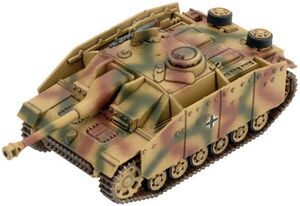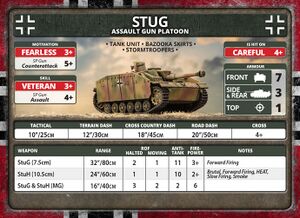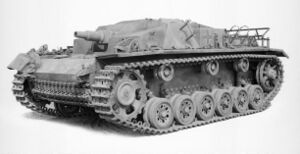Stug III: Difference between revisions
1d4chan>Redvsdead m (→IRL) |
1d4chan>MiaoKobayashisDragonMaid (→IRL) |
||
| Line 8: | Line 8: | ||
==Late War== | ==Late War== | ||
==IRL== | ==IRL== | ||
The | [[File:StuG III Ausf C-D.jpg|thumb|right|It's cold in Russia, okay]] | ||
The StuG was developed originally to fit a niche in the German army for armored assault guns for fighting in Urban environments and entrenched units. Developed on the speedy Panzer III chassis, the first Stug IIIs were equipped with puny <s>limp dicks </s> 75mm howitzers and pintle-mounted MG34s. These assault guns weren't meant to engage enemy armor, but were instead meant to breach static fortifications. | |||
Stugs served reliably until the end of the war and were produced until Hitler decided to ragequit life. The Stug was operated by many countries, including Bulgaria, Syria, Romania, Italy, and Hungary. Interestingly, the Stug was technically attached to German Artillery companies, | The Stug saw a complete change of service after Operation Barbarossa, when German armor began engaging Soviet vehicles en masse; the first few tank battles involved Panzer IIIs (armed with long-barreled 57mm guns that the germans used for anti-tank combat) and Panzer IVs (which filled the same anti-fortifcation role that the Stug had, originally armed with the same stubby 75mm that the Stug used). The Panzer III, while miles ahead of other early-war tanks, had a hard time dealing with [[KV|heavier]] and [[T-34|angled]] Soviet armor, and its turret was too small to house the 75mm cannons they used to deal with them. And so the Germans made a decision to switch their roles, equipping Panzer IVs with 75mm cannons, and converting Panzer IIIs and Stug Bs to the Stug F, which was dedicated to the tank-destroyer role. | ||
Later upgrades to the vehicle included the same remote controlled MG found on the Hetzer, as well as armored skirts called Schurzen, which were largely used by Germany to give their heavier tanks added protection against hits on the side from light caliber guns, rockets, and AT-Rifle rounds. | |||
Stugs served reliably until the end of the war and were produced until Hitler decided to ragequit life. The Stug was operated by many countries, including Bulgaria, Syria, Romania, Italy, and Hungary. Interestingly, the Stug was technically attached to German Artillery companies, mostly because the Tank and Infantry companies couldn't afford to take any more vehicles without more manpower that they didn't have, but also because of the fact that early Stugs were considered fire support, not dedicated tanks. Later in the war, Stug production was ramped up as the Germans lost valuable materiel and were having trouble producing their more advanced heavies. | |||
{{Template:German Forces in Flames of War}} | {{Template:German Forces in Flames of War}} | ||
Revision as of 17:00, 30 April 2022

As you may have read the other tank destroyer pages on this wiki, you may think to yourself, "Damn the Germans must have really hated tanks!". On the contrary, the Germans loved tanks so very very much. However, they hated everyone else's tanks, to the point they constantly devised new ways to kill, maim, and or outright annihilate enemy tanks, some more successful than others. The Stug III was one of those successes, armored, low-profile and armed with a powerful 75mm gun. The Stug III was a powerful tool in the hands of the Germans and was their most produced assault gun/tank destroyer and their second most produced armored vehicle after the SdKfz 251.
Early War

Mid War
Late War
IRL

The StuG was developed originally to fit a niche in the German army for armored assault guns for fighting in Urban environments and entrenched units. Developed on the speedy Panzer III chassis, the first Stug IIIs were equipped with puny limp dicks 75mm howitzers and pintle-mounted MG34s. These assault guns weren't meant to engage enemy armor, but were instead meant to breach static fortifications.
The Stug saw a complete change of service after Operation Barbarossa, when German armor began engaging Soviet vehicles en masse; the first few tank battles involved Panzer IIIs (armed with long-barreled 57mm guns that the germans used for anti-tank combat) and Panzer IVs (which filled the same anti-fortifcation role that the Stug had, originally armed with the same stubby 75mm that the Stug used). The Panzer III, while miles ahead of other early-war tanks, had a hard time dealing with heavier and angled Soviet armor, and its turret was too small to house the 75mm cannons they used to deal with them. And so the Germans made a decision to switch their roles, equipping Panzer IVs with 75mm cannons, and converting Panzer IIIs and Stug Bs to the Stug F, which was dedicated to the tank-destroyer role.
Later upgrades to the vehicle included the same remote controlled MG found on the Hetzer, as well as armored skirts called Schurzen, which were largely used by Germany to give their heavier tanks added protection against hits on the side from light caliber guns, rockets, and AT-Rifle rounds.
Stugs served reliably until the end of the war and were produced until Hitler decided to ragequit life. The Stug was operated by many countries, including Bulgaria, Syria, Romania, Italy, and Hungary. Interestingly, the Stug was technically attached to German Artillery companies, mostly because the Tank and Infantry companies couldn't afford to take any more vehicles without more manpower that they didn't have, but also because of the fact that early Stugs were considered fire support, not dedicated tanks. Later in the war, Stug production was ramped up as the Germans lost valuable materiel and were having trouble producing their more advanced heavies.
| German Forces in Flames of War | |
|---|---|
| Tanks: | Panzer II - Panzer III - Panzer IV - Panther - Tiger - Tiger II - Panzer 38(t) - Captured Tank Platoon (Germany) |
| Transports: | SdKfz 250 - SdKfz 251 - Opel Blitzwagen |
| Infantry: | MG34 Platoon - AT-Rifle Team - Assault Pioneer Platoon - Grenadier Company - Fallshirmjager Company |
| Artillery: | PaK-40 Anti-Tank Gun - Hummel - Panzerwerfer 42 - Wespe - Grille - PaK-43 - 12cm Mortar - 8cm Mortar - 21cm Nebelwerfer 42 - 30cm Nebelwerfer 42 |
| Tank Destroyers and Assault guns: | Marder - StuG III - Jagdpanzer IV - Nashorn - Elefant - Jagdtiger - Brummbar - Hetzer - Sturmpanzer II Bison |
| Armored Cars: | SdKfz. 234/2 'Puma' - Sd.Kfz 222/223 - SdKfz. 231 |
| Aircraft: | JU-87 Stuka - HS-129 - ME-262 Sturmvogel |
| Anti-Aircraft: | Flak 88mm - Flakpanzer IV Wirbelwind & Ostwind |